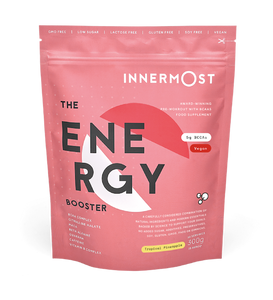When the zombie apocalypse hits, this is the article you'll thank your lucky stars that you've read...
Not only that, being able to run fast is important for your fitness, as it's correlated with increased strength and power. So, while we wait for the dead to rise (or, more accurately, keep our fingers crossed that they don’t), we've collated some advice on how to run like the wind, become stronger and burn more fat during your workouts.
If you've clicked on this article, you may be wondering how you can increase your running pace. Perhaps you’re training for a race, looking to increase your stamina, or really are training for the zombie apocalypse – whatever the reason, we’re here to help.
Firstly, it’s important to note that what you put into your body is just as important as how you move it. For all you runners out there, take a closer look at The Fit Protein to help you strengthen and replenish after a tough sprint session, and for that extra push, check out The Energy Booster for the energy kick you need to push yourself harder, train for longer and grow towards those all-important fitness goals.
Now without further ado, here's how to run faster, and improve your run time in six simple steps.
1. Perfect your form
Now you know that you need to effectively fuel your body before a run or a workout, let’s take a look at your form. Working on the technical aspects of your sprinting is essential to help you run fast. That’s a fact.
When Olympic sprinters dash for the finish line, one thing they all have in common is their running technique. But what is that technique, and how can we incorporate that into our personal techniques?
When they burst out of the blocks they lean forward, pump their arms, and keep their head down as they accelerate. As the race goes on they get taller, their contact time with the ground decreases, and their legs move exceptionally quickly.
So even if you're running to beat your personal best rather than a gold medal, this is the running form that you should be looking for. Whatever the reason you’re running, good form is essential. Unfortunately, it's not as straight forward as you may wish, the science behind the perfect running form is more than half of the task. Ensuring your body is ready and in the right form is crucial.
2. Warm up
First up, prepping for your workout is key, and warming up is essential. When it comes to warming up for a run, and advice around how to run faster: Dynamic Drills are the way forward for sprinting. Dynamic Drills help get your blood pumping, and temperature up.
Start with 10 minutes of moderate aerobic activity, such as a light jog. Then move into some dynamic mobility drills such as skips, high knees and arm swings to loosen up your hips, ankles and shoulders. Just keep moving to keep your heartrate up and to keep your body warm.
If you’re one to wonder, “how can I run faster”, it's time to really take into consideration that you need to warm up so that your body doesn’t hurt itself, as running is hard enough. If you take the time to prepare your body for sprinting, you'll run faster and reduce the chances of injury. The last thing you want is a sprained ankle keeping you on the sofa for a month.
Why am I struggling to increase my running pace?
You can’t expect to run faster when your body isn’t ready, and this could be why you’re not seeing the results that you want. Especially when you’re expecting to improve your run speed. Ensure you really take that time to get your mind and your body ready for the run so you are prepared to achieve your fitness goals.
3. Don't waste energy
It’s essential that you don’t waste energy when you run. You need to use everything you have to propel yourself forward as fast as possible. It’s important that you conserve your energy and that you don’t waste it.
To increase your run speed your legs need to move faster, which requires more energy. You should pump your arms, keep your hips steady, your chin in and your stride short. Lean forward slightly and aim to land on your mid-foot, as this will help prevent your strides from becoming too large.
Conserve your energy throughout the run and stick to a pace that works for you and that you feel comfortable.
4. Start trying out some speed sessions
If you were wondering how to increase your running pace, look no further.
“How to increase your run time” and "how to increase your run speed" are two hugely popular searches on the internet, and thankfully, here at Innermost, we’ve got the answer.
How to run faster and longer
Try doing 10 x 50m or 10 second maximal sprints with full recovery between each one. Adding this to your workout will improve your conditioning for any sport you play, as well as your day-to-day life. As you work through your plan make, sure to keep refining your technique to make sure you keep improving.
Training your body to handle a certain speed takes practice. Learning to increase your running pace won’t happen overnight.
Just keep persevering and trying your best and your body will adapt to what you’re asking it to do. You could even try workout techniques such as Fartlek Training - which is a great way to improve your stamina and performance.
5. Surprisingly: hills help
When you need to mix up your workouts and really test your speed, try doing some resisted sprints to get you on the road being a faster and more powerful sprinter.
Hill sprints are a fun, challenging way of adding resistance to your workouts. Find a moderately sloped hill and do hill repeats as many times as you can.
When you’re beginning to think that you know you can do better and you’re wondering how you can improve your running time, try pushing yourself to the extreme as once you’ve got the hang of sprinting or running up a hill.
When it comes back to it, running on a flat road will be much easier and you will notice that your body has been conditioned to more than normal running.
6. Lift and resist for speed
Let's face it, you need to be strong to run fast.
Resistance training combined with speed workouts is a great way to improve your power. Focus on exercises such as squats, lunges and deadlifts to get your legs and core stronger. Getting your muscles stronger means that they are capable of doing more. Getting those muscles awake and ready to be pushed means that your body can handle more.
These exercises will help you to recruit the fast twitch muscles that you need to run faster and more powerfully. Try adding strength workouts to your routine two to three times a week to see fast results. Stability and form all depends on your muscles and how they are carrying your body.
The more muscles you have to help your body achieve your goals, the more times you can it!



















